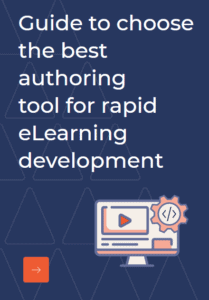Over the past decade, there has been a significant change in the way in which organizations address their training requirements. Right from induction to onboarding to skill-based training, eLearning plays a crucial role. As Dion Love, Gartner VP, Advisory, says, “The digital economy is also booming, making it tough for companies to find and compete for certain talent, so organizations are working overtime to court newly empowered candidates.”
Our previous posts have covered how to step up the onboarding game with eLearning and how eLearning can be used to give a WOW Onboarding Experience, and how it helps in cost reduction. Promotional activities and onboarding strategies to make the new joiners feel welcomed is the new strategy that HR has been deploying, but does that suffice? As Dion Love points out, though in the context of recruitment (works for onboarding too), “with organizations going all out to rope in the joints, in reality, may feel: Overwhelmed- due to the information overload. Overlooked- due to the number of joinees in the group. And Regretful- as they may feel that their talent is being wasted.” While eLearning can bring down the feeling of being overlooked, it is the content and the design that determines whether the newly joined employees feel overwhelmed, regretful or highly engaged and motivated.
It is essential to ensure that the onboarding efforts cater to employee engagement and building optimism. To do so, here are some tips on how to develop an onboarding eLearning programme for new joinees or new hires.
Planning
Onboarding is a long-term process and any training designed for the same should essentially be planned and segmented to either daily learning or weekly learning schedule. Don’t go teaching the new joinees the complexities of the profile on the very first day, start small and simple. Let the first day be about acclimatization, a tad bit about critical rules or compliance requirements, and nothing more.
Stick to the Core Messaging
eLearning provides the option to be creative, but in the rush to create engaging learning it is essential to not forget about the core message that must be relayed. Know what kind of impression is to be left on the newly hired and develop the course in alignment with the same. Ensure that a consistent message is delivered as long as the onboarding training continues.
Focus on Individual Strengths
Onboarding is a way to win loyalty and ensure employee retention too. But that would only happen if the individuals (new joinees) feel like their talents or expertise and experience are appreciated. Try to create an onboarding programme that allows the learners to understand their strengths and weaknesses and provides an arena for exploring what suits their level of expertise. This would indirectly mean personalized learning that caters to individual skill-sets.
Incorporate Gamification, Social Learning
Onboarding is about making the new hires appreciate the workplace, enjoy interactions with peers, understand their roles and responsibilities on-premise. What better way than to utilize the perks of gamification and social learning to do so. Develop eLearning programmes that are exploratory, provide users the option to choose their path or course of actions. Also add social media elements to support interaction, discussion, collective problem solving etc.
Allow Learners to Find Mentors
Social learning could go beyond the community aspect to finding like-minded individuals who can help or mentor each other. In case of new joinees the mentors can be long-term employees who can give a better overview about the day-to-day routine, performance requirements, policies and all things that are relevant to the functioning of the organization as a whole.
Include Scenarios
Nothing works better than real-life experiences when it comes to describing precautions or critical rules. Include real-life scenarios, experiences and case studies from the past to give the newly hired employees a gist about the severity of non-compliance or errors. If anything, this approach could be like giving a fair warning and ensuring that the important aspects are ingrained in the employee’s mind.
In addition to those, it is important to develop an onboarding eLearning programme that is multidevice, multi-language compatible and most importantly user-friendly. The last thing you want is to create a ‘how-to’ course for the onboarding programme. It is advisable to utilize authoring tools for designing onboarding for faster deployment and faster modifications too if need be. Also, don’t forget to add tracking features and assessments to understand just how well the new joinees comprehend the onboarding eLearning content.
Does your organization use eLearning for onboarding? If not, why? And if yes, do share your thoughts on the aspects you feel are missing. You can also, send us a message in case of specific queries.



